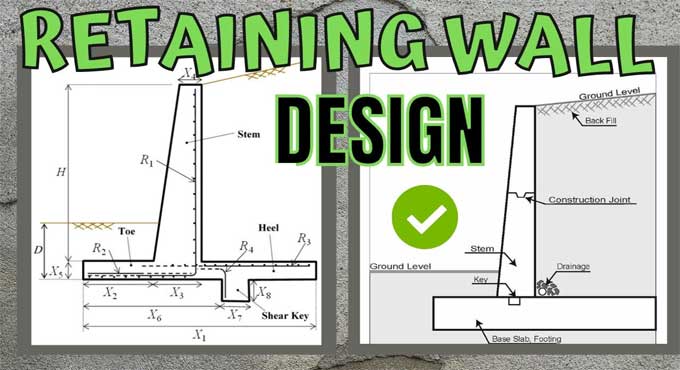NEWS | SOFTWARE | SHEET
Retaining Wall Design - Analysis of Concrete Retaining Walls
Different components of Retaining Walls are discussed, as well as their design principles according to different factors and materials. In general, any wall that is capable of sustaining significant soil pressure lateral to it is considered a retaining wall.
It is usually used to refer to freestanding walls without lateral support at their top, such as a cantilever retaining wall. It is crucial to consider the actual dimensions of the ground level difference for which the wall is designed.
Choose the Right Location of Retaining Wall
- Reduce the amount of soil that needs to be excavated and backfilled.
- Develop drainage patterns and optimize grading.
- Ensure existing features of the site are considered.
Calculate Height & Geometry of Retaining Wall
- Determine the height of the tallest part of the retaining wall.
- The slopes above and below the wall need to be identified.
- Evaluate traffic surcharges from construction or vehicular traffic.
- You can select the appropriate wall batter or setback based on your needs.
Soil Properties
The soil properties of natural ground and backfill should be determined in advance of design for walls higher than 5 meters, especially those with sloping backfill. Additionally, ground water levels should be determined with special attention to maximum probable levels.
The soil properties of less important walls can be estimated from previous tests on similar materials. In order to verify that the assumed material type is accurate, a careful visual examination of the materials, particularly those at the proposed foundation level, should be performed.
Earth Pressure
The lateral deformations in soil strongly influence earth pressure acting on earth retaining structures. The magnitude and distribution of each pressure in the structure cannot be rationally predicted unless the deformation condition can be estimated with reasonable accuracy.
An active pressure of minimum force can only be exerted against a wall when it moves sufficiently outward to allow the soil behind it to expand laterally and reach a state of plastic equilibrium. When the wall moves toward the soil, the maximum passive pressure occurs. Depending on the type of backfill material, the amount of movement needed to reach these failure conditions will vary.
Basic Load
To design a safe system, the pressure loading should be based on the following: Normal Loading equals static earth pressure plus water pressure due to living loads or surcharges. It is generally recommended that earth-retaining structures have a design pressure equal to the force due to fluids of a unit mass of 5kN/m3.
Backfill Selection & Application
The provision of drainage is essential for cohesive backfills to prevent the buildup of water pressure. It is found that clays vary in moisture content from one season to another, resulting in swelling and shrinkage. Clay backfills with fine grained particles are not recommended in general. Using these soils as backfill may cause increased pressure against a wall.
Cohesion-less material are less prone to long term settlement problems because of consolidation. It may not be necessary to pay the same amount of attention to free-draining cohesion-less materials in this regard.
A properly designed filter layer may still be required to protect them. Final material choices should be determined by the cost and availability of such materials, in balance with the cost of more expensive walls.
Proper Checking for Quality Materials
Confirm that the block delivered matches the AB unit on the approved plans based on color, style, and setback.
Be sure that the geo-grid delivered meets the grid specified on the engineered plans for strength, weight, roll size, strength direction, and manufacturer.
There are several types of geo-grids that can help you while checking any kind of materials.
To get more clear ideas, go through the following exclusive construction video tutorial.
Lecturer and Image Source: Kestävä
Recommended Articles:
How to Calculate Quantity of Stone for Retaining Wall
How to Compute Concrete Volume for Retaining Wall


